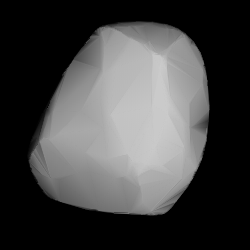 Modelled shape of Brigitta from its lightcurve | |
| Discovery | |
|---|---|
| Discovered by | M. F. Wolf A. Schwassmann |
| Discovery date | 10 October 1899 |
| Designations | |
| (450) Brigitta | |
| Pronunciation | German: [brɪˈɡɪtaː] [1] |
| 1899 EV | |
| Main belt (Eos) | |
| Orbital characteristics [2] | |
| Epoch 31 July 2016 (JD 2457600.5) | |
| Uncertainty parameter 0 | |
| Observation arc | 116.51 yr (42557 d) |
| Aphelion | 3.31399 AU (495.766 Gm) |
| Perihelion | 2.72067 AU (407.006 Gm) |
| 3.01733 AU (451.386 Gm) | |
| Eccentricity | 0.098320 |
| 5.24 yr (1914.4 d) | |
| 125.651° | |
| 0° 11m 16.976s / day | |
| Inclination | 10.1548° |
| 14.4643° | |
| 356.379° | |
| Physical characteristics | |
| Dimensions | 33.32±1.3 km |
| 10.75 h (0.448 d) | |
| 0.1229±0.010 | |
| 10.2 | |
450 Brigitta is a typical Main belt asteroid. It is a member of the Eos family. [3]
It was discovered by Max Wolf and A. Schwassmann on 10 October 1899 in Heidelberg.